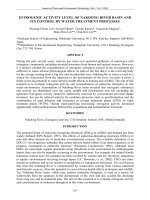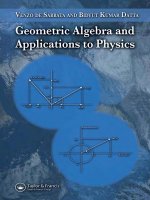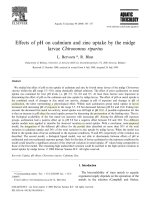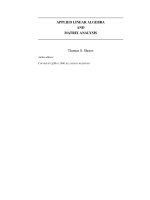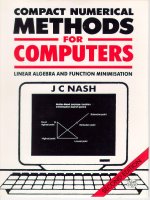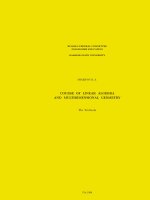Algebra-and-Trigonometry-Solution-by-Sheldon-Axler
Bạn đang xem bản rút gọn của tài liệu. Xem và tải ngay bản đầy đủ của tài liệu tại đây (13.46 MB, 782 trang )
This page intentionally left blank
www.pdfgrip.com
accessible, affordable,
active learning
!"#$%&'()*#+*,-*#--(.,/#.%0*1%+%,1'234,+%50*(-$#-%*%-.#1(-)%-/*6(1*
%66%'/#.%*/%,'2#-7*,-5*$%,1-#-7"
!"#$%&'()%%%
:;-123)1($&$1#0(+1$&<21=&
&&&&/-+>0(+/(?6--$12+@&
&&&&A((06)/7&)+0&!*--A&-A&
&&&&!*-@*($$B&CDEF%
:$#!!-*1$&2+$1*#/1-*$&<21=&
&&&&*("2)6"(&*($-#*/($&1=)1&
&&&&*(2+A-*/(&/-#*$(&@-)"$&
&&&&2+$20(&)+0&-#1$20(&-A&
&&&&1=(&/")$$*--;%&
.+/"#0($&
.+1(*)/123(&
4(516--7&8&
9($-#*/($
!"#$%&'()%%%&'()*+&,-*(%
!!!"!#$%&!"#$"'()
www.pdfgrip.com
G''&4HI&HI'JB&9IKLM9NIKB&GOP&JI9KLOG'&KMJJL94
QLM&GOP&QLM9&K4MPIO4K&OIIPR
<<<%<2"(S!"#$%/-;E*($-#*/($
<3E#-:/%*8:/(1#,$+*,-5*,$$*
(6*/2%*1%+(:1'%+*&(:*I*&(:1
+/:5%-/+*-%%5*/(*7%/*+/,1/%5"
9/:5%-/*+:;;(1/*61()*,-*
%C;%1#%-'%5*+/:5%-/*:+%1"
F1%3$(,5%50*1%,5&3/(3:+%*
,++#7-)%-/+*,-5*;1%+%-/,/#(-+"
G1%,/%5*4&*+:4H%'/*),//%1*%C;%1/+"
8%'2-#',$*9:;;(1/*<=>?
@AB+0*(-$#-%*'2,/0
,-5*;2(-%*+:;;(1/"
<<<%<2"(S!"#$%/-;E$#!!-*1
www.pdfgrip.com
G($$,4(1,/%*!#/2*&(:1*'($$%,7:%+0*
6#-5*,*)%-/(10*,//%-5*.#1/:,$*,-5*$#.%*
%.%-/+0*,-5*.#%!*1%+(:1'%+"
*<<<%T=(*(U)/#"1SN-++(/1%/-;
D(:1*!"#$%&'()*A''(:-/*E,-,7%1"
F%1+(-,$*/1,#-#-7*,-5*
#);$%)%-/,/#(-*+:;;(1/"
1
Θ
6Π
5Π
4Π
3Π
2Π
Π
Π
2Π
3Π
4Π
5Π
6Π
1
Algebra &
Trigonometry
with
Student Solutions Manual
Sheldon Axler
San Francisco State University
JOHN WILEY & SONS, INC.
www.pdfgrip.com
Vice President and Executive Publisher
Acquisitions Editor
Project Editor
Assistant Editor
Development Editor
Senior Production Editor
Photo Editor
Marketing Manager
Design Director
Media Editor
Media Assistant
Laurie Rosatone
Joanna Dingle
Ellen Keohane
Beth Pearson
Anne Scanlan-Rohrer
Ken Santor
Mary Ann Price
Jonathan Cottrell
Madelyn Lesure
Melissa Edwards
Lisa Sabatini
This book was typeset in pdfLATEX by the author. Printing and binding by RR
Donnelley, Jefferson City. Cover printed by Phoenix Color Corporation.
About the Cover
The diagram on the cover shows a graph of the cosine function.
This book is printed on acid free paper. ∞
Copyright © 2012 John Wiley & Sons, Inc. All rights reserved. No part of this publication may
be reproduced, stored in a retrieval system or transmitted in any form or by any means,
electronic, mechanical, photocopying, recording, scanning or otherwise, except as permitted
under Sections 107 or 108 of the 1976 United States Copyright Act, without either the prior
written permission of the Publisher or authorization through payment of the appropriate
per-copy fee to the Copyright Clearance Center, Inc., 222 Rosewood Drive, Danvers, MA 01923,
web site www.copyright.com. Requests to the Publisher for permission should be addressed
to the Permissions Department, John Wiley & Sons, Inc., 111 River Street, Hoboken, NJ
07030-5774, (201) 748-6011, fax (201) 748-6008, web site www.wiley.com/go/permissions.
Evaluation copies are provided to qualified academics and professionals for review purposes
only, for use in their courses during the next academic year. These copies are licensed and
may not be sold or transferred to a third party. Upon completion of the review period, please
return the evaluation copy to Wiley. Return instructions and a free of charge return shipping
label are available at www.wiley.com/go/returnlabel. Outside of the United States, please
contact your local representative.
To order books or for customer service please, call 1-800-CALL WILEY (225-5945).
ISBN-13
ISBN-13
ISBN-13
978-0470-58579-5 (hardcover)
978-0470-47081-7 (softcover)
978-0470-47082-4 (binder ready)
Printed in the United States of America
10 9 8 7 6 5 4 3 2 1
www.pdfgrip.com
About the Author
Sheldon Axler is Dean of
the College of Science & Engineering at San Francisco
State University, where he
joined the faculty as Chair of the Mathematics Department in 1997.
Axler was valedictorian of his high school in Miami, Florida. He received
his AB from Princeton University with highest honors, followed by a PhD in
Mathematics from the University of California at Berkeley.
As a postdoctoral Moore Instructor at MIT, Axler received a university-wide
teaching award. Axler was then an assistant professor, associate professor,
and professor at Michigan State University, where he received the first J.
Sutherland Frame Teaching Award and the Distinguished Faculty Award.
Axler received the Lester R. Ford Award for expository writing from the
Mathematical Association of America in 1996. In addition to publishing
numerous research papers, Axler is the author of Linear Algebra Done Right
(which has been adopted as a textbook at over 240 universities and colleges),
College Algebra, and Precalculus: A Prelude to Calculus; he is also co-author
of Harmonic Function Theory (a graduate/research-level book).
Axler has served as Editor-in-Chief of the Mathematical Intelligencer and as
Associate Editor of the American Mathematical Monthly. He has been a member of the Council of the American Mathematical Society and a member of
the Board of Trustees of the Mathematical Sciences Research Institute. Axler
currently serves on the editorial board of Springer’s series Undergraduate
Texts in Mathematics, Graduate Texts in Mathematics, and Universitext.
v
www.pdfgrip.com
Contents
About the Author
v
Preface to the Instructor
WileyPLUS
xvi
xxii
Acknowledgments
xxiii
Preface to the Student
1 The Real Numbers
1
1.1 The Real Line
2
xxvi
Construction of the Real Line
2
Is Every Real Number Rational?
Problems
3
6
1.2 Algebra of the Real Numbers
7
Commutativity and Associativity
7
The Order of Algebraic Operations
The Distributive Property
8
10
Additive Inverses and Subtraction
11
Multiplicative Inverses and the Algebra of Fractions
Symbolic Calculators
16
Exercises, Problems, and Worked-out Solutions
1.3 Inequalities, Intervals, and Absolute Value
Positive and Negative Numbers
Lesser and Greater
Intervals
13
19
24
24
25
27
Absolute Value
30
Exercises, Problems, and Worked-out Solutions
33
Chapter Summary and Chapter Review Questions
vi
www.pdfgrip.com
40
Contents vii
2 Combining Algebra and Geometry
2.1 The Coordinate Plane
Coordinates
41
42
42
Graphs of Equations
44
Distance Between Two Points
46
Length, Perimeter, and Circumference
48
Exercises, Problems, and Worked-out Solutions
2.2 Lines
57
Slope
57
The Equation of a Line
Parallel Lines
Midpoints
58
61
Perpendicular Lines
62
64
Exercises, Problems, and Worked-out Solutions
2.3 Quadratic Expressions and Conic Sections
Completing the Square
75
The Quadratic Formula
77
Circles
66
75
79
Ellipses
81
Parabolas
Hyperbolas
83
85
Exercises, Problems, and Worked-out Solutions
2.4 Area
50
88
98
Squares, Rectangles, and Parallelograms
Triangles and Trapezoids
Stretching
98
99
101
Circles and Ellipses
102
Exercises, Problems, and Worked-out Solutions
105
Chapter Summary and Chapter Review Questions
3 Functions and Their Graphs
3.1 Functions
117
118
Definition and Examples
118
The Graph of a Function
121
The Domain of a Function
The Range of a Function
124
126
www.pdfgrip.com
115
viii Contents
Functions via Tables
128
Exercises, Problems, and Worked-out Solutions
3.2 Function Transformations and Graphs
129
142
Vertical Transformations: Shifting, Stretching, and Flipping
Horizontal Transformations: Shifting, Stretching, Flipping
Combinations of Vertical Function Transformations
Even Functions
152
Odd Functions
153
Exercises, Problems, and Worked-out Solutions
3.3 Composition of Functions
165
Definition of Composition
166
Order Matters in Composition
149
154
169
170
Composing More than Two Functions
171
Function Transformations as Compositions
172
Exercises, Problems, and Worked-out Solutions
3.4 Inverse Functions
174
180
The Inverse Problem
180
One-to-one Functions
181
The Definition of an Inverse Function
182
The Domain and Range of an Inverse Function
184
The Composition of a Function and Its Inverse
185
Comments About Notation
187
Exercises, Problems, and Worked-out Solutions
3.5 A Graphical Approach to Inverse Functions
The Graph of an Inverse Function
Increasing and Decreasing Functions
Inverse Functions via Tables
189
197
197
Graphical Interpretation of One-to-One
199
200
203
Exercises, Problems, and Worked-out Solutions
204
Chapter Summary and Chapter Review Questions
4 Polynomial and Rational Functions
4.1 Integer Exponents
145
165
Combining Two Functions
Decomposing Functions
142
214
Positive Integer Exponents
214
www.pdfgrip.com
213
209
Contents ix
Properties of Exponents
Defining x
0
215
217
Negative Integer Exponents
218
Manipulations with Exponents
219
Exercises, Problems, and Worked-out Solutions
4.2 Polynomials
221
227
The Degree of a Polynomial
227
The Algebra of Polynomials
228
Zeros and Factorization of Polynomials
230
The Behavior of a Polynomial Near ±∞
234
Graphs of Polynomials
237
Exercises, Problems, and Worked-out Solutions
4.3 Rational Functions
239
245
Ratios of Polynomials
245
The Algebra of Rational Functions
Division of Polynomials
246
247
The Behavior of a Rational Function Near ±∞
Graphs of Rational Functions
250
253
Exercises, Problems, and Worked-out Solutions
4.4 Complex Numbers
255
262
The Complex Number System
262
Arithmetic with Complex Numbers
263
Complex Conjugates and Division of Complex Numbers
Zeros and Factorization of Polynomials, Revisited
Exercises, Problems, and Worked-out Solutions
271
Chapter Summary and Chapter Review Questions
5 Exponents and Logarithms
276
279
5.1 Exponents and Exponential Functions
Roots
264
268
280
280
Rational Exponents
Real Exponents
284
285
Exponential Functions
286
Exercises, Problems, and Worked-out Solutions
287
5.2 Logarithms as Inverses of Exponential Functions
Logarithms Base 2
293
www.pdfgrip.com
293
x Contents
Logarithms with Any Base
295
Common Logarithms and the Number of Digits
Logarithm of a Power
297
Radioactive Decay and Half-Life
299
Exercises, Problems, and Worked-out Solutions
5.3 Applications of Logarithms
Logarithm of a Product
301
310
310
Logarithm of a Quotient
311
Earthquakes and the Richter Scale
Sound Intensity and Decibels
312
313
Star Brightness and Apparent Magnitude
Change of Base
297
315
316
Exercises, Problems, and Worked-out Solutions
5.4 Exponential Growth
328
Functions with Exponential Growth
Population Growth
319
329
333
Compound Interest
335
Exercises, Problems, and Worked-out Solutions
340
Chapter Summary and Chapter Review Questions
6 e and the Natural Logarithm
6.1 Defining e and ln
349
350
Estimating Area Using Rectangles
Defining e
350
352
Defining the Natural Logarithm
355
Properties of the Exponential Function and ln
Exercises, Problems, and Worked-out Solutions
356
358
6.2 Approximations and area with e and ln 366
Approximation of the Natural Logarithm
366
Approximations with the Exponential Function
An Area Formula
368
369
Exercises, Problems, and Worked-out Solutions
6.3 Exponential Growth Revisited
376
Continuously Compounded Interest
Continuous Growth Rates
Doubling Your Money
377
378
www.pdfgrip.com
376
372
347
Contents xi
Exercises, Problems, and Worked-out Solutions
380
Chapter Summary and Chapter Review Questions
7 Systems of Equations
385
387
7.1 Equations and Systems of Equations
Solving an Equation
388
388
Solving a System of Equations Graphically
391
Solving a System of Equations by Substitution
Exercises, Problems, and Worked-out Solutions
7.2 Solving Systems of Linear Equations
Linear Equations: How Many Solutions?
Systems of Linear Equations
Gaussian Elimination
392
393
399
399
402
404
Exercises, Problems, and Worked-out Solutions
406
7.3 Solving Systems of Linear Equations Using Matrices
Representing Systems of Linear Equations by Matrices
Gaussian Elimination with Matrices
411
411
413
Systems of Linear Equations with No Solutions
415
Systems of Linear Equations with Infinitely Many Solutions
How Many Solutions, Revisited
Exercises, Problems, and Worked-out Solutions
7.4 Matrix Algebra
Matrix Size
419
424
424
Adding and Subtracting Matrices
426
Multiplying a Matrix by a Number
Multiplying Matrices
427
428
The Inverse of a Matrix
433
Exercises, Problems, and Worked-out Solutions
440
Chapter Summary and Chapter Review Questions
8 Sequences, Series, and Limits
8.1 Sequences
416
418
447
448
Introduction to Sequences
448
Arithmetic Sequences
450
Geometric Sequences
451
Recursively Defined Sequences
454
www.pdfgrip.com
445
xii Contents
Exercises, Problems, and Worked-out Solutions
8.2 Series
456
463
Sums of Sequences
463
Arithmetic Series
463
Geometric Series
466
Summation Notation
468
The Binomial Theorem
470
Exercises, Problems, and Worked-out Solutions
8.3 Limits
476
483
Introduction to Limits
Infinite Series
483
487
Decimals as Infinite Series
Special Infinite Series
489
491
Exercises, Problems, and Worked-out Solutions
493
Chapter Summary and Chapter Review Questions
9 Trigonometric Functions
9.1 The Unit Circle
497
498
The Equation of the Unit Circle
Angles in the Unit Circle
Negative Angles
498
499
501
Angles Greater Than 360◦
Length of a Circular Arc
502
503
Special Points on the Unit Circle
504
Exercises, Problems, and Worked-out Solutions
9.2 Radians
506
514
A Natural Unit of Measurement for Angles
The Radius Corresponding to an Angle
Length of a Circular Arc
Area of a Slice
514
517
520
521
Special Points on the Unit Circle
522
Exercises, Problems, and Worked-out Solutions
9.3 Cosine and Sine
523
529
Definition of Cosine and Sine
529
The Signs of Cosine and Sine
532
The Key Equation Connecting Cosine and Sine
www.pdfgrip.com
534
496
Contents xiii
The Graphs of Cosine and Sine
535
Exercises, Problems, and Worked-out Solutions
9.4 More Trigonometric Functions
Definition of Tangent
The Sign of Tangent
537
542
542
544
Connections Among Cosine, Sine, and Tangent
The Graph of Tangent
545
545
Three More Trigonometric Functions
547
Exercises, Problems, and Worked-out Solutions
9.5 Trigonometry in Right Triangles
555
Trigonometric Functions via Right Triangles
Two Sides of a Right Triangle
555
557
One Side and One Angle of a Right Triangle
558
Exercises, Problems, and Worked-out Solutions
9.6 Trigonometric Identities
549
559
566
The Relationship Among Cosine, Sine, and Tangent
566
Trigonometric Identities for the Negative of an Angle
Trigonometric Identities with
π
2
568
570
Trigonometric Identities Involving a Multiple of π
Exercises, Problems, and Worked-out Solutions
572
575
Chapter Summary and Chapter Review Questions
10 Trigonometric Algebra and Geometry
583
10.1 Inverse Trigonometric Functions
584
The Arccosine Function
The Arcsine Function
580
584
587
The Arctangent Function
590
Exercises, Problems, and Worked-out Solutions
10.2 Inverse Trigonometric Identities
593
599
Composition of Trigonometric Functions and Their Inverses
599
The Arccosine, Arcsine, and Arctangent of −t: Graphical
Approach 600
The Arccosine, Arcsine, and Arctangent of −t: Algebraic
Approach 602
Arccosine Plus Arcsine
The Arctangent of
1
t
603
604
More Compositions with Inverse Trigonometric Functions
www.pdfgrip.com
605
xiv Contents
Exercises, Problems, and Worked-out Solutions
10.3 Using Trigonometry to Compute Area
The Area of a Triangle via Trigonometry
Ambiguous Angles
613
613
614
The Area of a Parallelogram via Trigonometry
The Area of a Polygon
616
617
Trigonometric Approximations
619
Exercises, Problems, and Worked-out Solutions
10.4 The Law of Sines and the Law of Cosines
The Law of Sines
The Law of Cosines
628
629
631
Using the Law of Cosines
When to Use Which Law
632
634
Exercises, Problems, and Worked-out Solutions
10.5 Double-Angle and Half-Angle Formulas
The Sine of 2θ
636
644
644
645
The Tangent of 2θ
646
The Cosine and Sine of
The Tangent of
622
628
Using the Law of Sines
The Cosine of 2θ
608
θ
2
θ
2
647
649
Exercises, Problems, and Worked-out Solutions
10.6 Addition and Subtraction Formulas
The Cosine of a Sum and Difference
The Sine of a Sum and Difference
650
658
658
660
The Tangent of a Sum and Difference
661
Exercises, Problems, and Worked-out Solutions
662
Chapter Summary and Chapter Review Questions
11 Applications of Trigonometry
11.1 Parametric Curves
671
672
Curves in the Coordinate Plane
672
Graphing Inverse Functions as Parametric Curves
677
Shifting, Stretching, or Flipping a Parametric Curve
Exercises, Problems, and Worked-out Solutions
www.pdfgrip.com
681
678
668
Contents xv
11.2 Transformations of Trigonometric Functions
Amplitude
Period
687
687
689
Phase Shift
692
Fitting Transformations of Trigonometric Functions to Data
Exercises, Problems, and Worked-out Solutions
11.3 Polar Coordinates
696
705
Defining Polar Coordinates
705
Converting from Polar to Rectangular Coordinates
706
Converting from Rectangular to Polar Coordinates
707
Graphs of Polar Equations
711
Exercises, Problems, and Worked-out Solutions
11.4 Vectors
694
715
718
An Algebraic and Geometric Introduction to Vectors
Vector Addition
720
Vector Subtraction
723
Scalar Multiplication
The Dot Product
718
725
726
Exercises, Problems, and Worked-out Solutions
11.5 The Complex Plane
728
732
Complex Numbers as Points in the Plane
732
Geometric Interpretation of Complex Multiplication and Division
De Moivre’s Theorem
737
Finding Complex Roots
738
Exercises, Problems, and Worked-out Solutions
739
Chapter Summary and Chapter Review Questions
Photo Credits
Index
743
745
www.pdfgrip.com
741
734
Preface to the Instructor
Goals
This book aims to provide students with the algebraic and trigonometric
skills and understanding needed for other coursework and for participating
as an educated citizen in a complex society.
Mathematics faculty frequently complain that many students do not read
the textbook. When doing homework, a typical student may look only at
the relevant section of the textbook or the student solutions manual for
an example similar to the homework problem at hand. The student reads
enough of that example to imitate the procedure and then does the homework
problem. Little understanding may take place.
In contrast, this book is designed to be read by students. The writing
style and layout are meant to induce students to read and understand the
material. Explanations are more plentiful than typically found in algebra
and trigonometry books. Examples of the concepts make the ideas concrete
whenever possible.
Exercises and Problems
Each exercise has a
unique correct answer, usually a number or a function;
most problems have
multiple correct answers, usually explanations or examples.
This book contains
what is usually
a separate book
called the student
solutions manual.
Students learn mathematics by actively working on a wide range of exercises
and problems. Ideally, a student who reads and understands the material in
a section of this book should be able to do the exercises and problems in
that section without further help. However, some of the exercises require
application of the ideas in a context that students may not have seen before;
many students will need help with these exercises. This help is available
from the complete worked-out solutions to all the odd-numbered exercises
that appear at the end of each section.
Because the worked-out solutions were written solely by the author of
the textbook, students can expect a consistent approach to the material.
Furthermore, students will save money by not having to purchase a separate
student solutions manual.
The exercises (but not the problems) occur in pairs, so that an oddnumbered exercise is followed by an even-numbered exercise whose solution
uses the same ideas and techniques. A student stumped by an even-numbered
exercise should be able to tackle it after reading the worked-out solution to
the corresponding odd-numbered exercise. This arrangement allows the text
to focus more centrally on explanations of the material and examples of the
concepts.
xvi
www.pdfgrip.com
Preface to the Instructor xvii
Most students will read the student solutions manual when they are
assigned homework, even though they are reluctant to read the main text.
The integration of the student solutions manual within this book should
encourage students to drift over and also read the main text. To reinforce
this tendency, the worked-out solutions to the odd-numbered exercises at
the end of each section are intentionally typeset with a slightly less appealing
style (smaller type, two-column format, and not right justified) than the main
text. The reader-friendly appearance of the main text might nudge students
to spend some time there.
Exercises and problems in this book vary greatly in difficulty and purpose.
Some exercises and problems are designed to hone algebraic manipulation
skills; other exercises and problems are designed to push students to genuine
understanding beyond rote algorithmic calculation.
Some exercises and problems intentionally reinforce material from earlier
in the book and require multiple steps. For example, Exercise 30 in Section 5.3
asks students to find all numbers x such that
log5 (x + 4) + log5 (x + 2) = 2.
To solve this exercise, students will need to use the formula for a sum of
logarithms as well as the quadratic formula; they will also need to eliminate
one of the potential solutions produced by the quadratic formula because it
would lead to the evaluation of the logarithm of a negative number. Although
such multi-step exercises require more thought than most exercises in the
book, they allow students to see crucial concepts more than once, sometimes
in unexpected contexts.
The Calculator Issue
The issue of whether and how calculators should be used by students has
generated immense controversy.
Some sections of this book have many exercises and problems designed
for calculators (for example Section 5.4 on exponential growth), but some
sections deal with material not as amenable to calculator use. The text seeks
to provide students with both understanding and skills. Thus the book
does not aim for an artificially predetermined percentage of exercises and
problems in each section requiring calculator use.
Some exercises and problems that require a calculator are intentionally
designed to make students realize that by understanding the material, they
can overcome the limitations of calculators. As one example among many,
Exercise 83 in Section 5.3 asks students to find the number of digits in the
decimal expansion of 74000 . Brute force with a calculator will not work with
this problem because the number involved has too many digits. However, a
few moments’ thought should show students that they can solve this problem
by using logarithms (and their calculators!).
www.pdfgrip.com
To aid instructors in
presenting the kind of
course they want, the
symbol
appears
with exercises and
problems that require
students to use a calculator.
xviii Preface to the Instructor
Regardless of what
level of calculator use
an instructor expects,
students should not
turn to a calculator
to compute something like log 1, because then log has
become just a button on the calculator.
The calculator icon
can be interpreted for some exercises, depending
on the instructor’s preference, to mean that the solution should be a decimal
approximation rather than the exact answer. For example, Exercise 3 in
Section 6.3 asks how much would need to be deposited in a bank account
paying 4% interest compounded continuously so that at the end of 10 years
the account would contain $10,000. The exact answer to this exercise is
10000/e0.4 dollars, but it may be more satisfying to the student (after obtaining the exact answer) to use a calculator to see that approximately $6,703
needs to be deposited.
For exercises such as the one described in the paragraph above, instructors
can decide whether to ask for exact answers or decimal approximations or
both (the worked-out solutions for the odd-numbered exercises will usually
contain both). If an instructor asks for only an exact answer, then a calculator
may not be needed despite the presence of the calculator icon.
Symbolic processing programs such as Mathematica and Maple offer appealing alternatives to hand-held calculators because of their ability to solve
equations and deal with symbols as well as numbers. Furthermore, the larger
size, better resolution, and color on a computer screen make graphs produced by such software more informative than graphs on a typical hand-held
graphing calculator.
Your students may not use a symbolic processing program because of the
complexity or expense of such software. However, easy-to-use free web-based
symbolic programs are becoming available. Occasionally this book shows
how students can use Wolfram|Alpha, which has almost no learning curve, to
go beyond what can be done easily by hand.
Even if you do not tell your students about such free tools, knowledge
about such web-based homework aids is likely to spread rapidly among
students.
Distinctive Approaches
Half-life and Exponential Growth
Almost all algebra and trigonometry books present radioactive decay as an
example of exponential decay. Amazingly, the typical algebra and trigonometry textbook states that if a radioactive isotope has half-life h, then the
amount left at time t will equal e−(t ln 2)/h times the amount present at time 0.
A much clearer formulation would state, as this textbook does, that the
amount left at time t will equal 2−t/h times the amount present at time 0. The
unnecessary use of e and ln 2 in this context may suggest to students that e
and natural logarithms have only contrived and artificial uses, which is not
the message a textbook should send. Using 2−t/h helps students understand
the concept of half-life, with a formula connected to the meaning of the
concept.
Similarly, many algebra and trigonometry textbooks consider, for example,
a colony of bacteria doubling in size every 3 hours, with the textbook then
www.pdfgrip.com
Preface to the Instructor xix
producing the formula e(t ln 2)/3 for the growth factor after t hours. The
simpler and more natural formula 2t/3 seems not to be mentioned in such
books. This book presents the more natural approach to such issues of
exponential growth and decay.
Algebraic Properties of Logarithms
The base for logarithms in Chapter 5 is arbitrary. Most of the examples and
motivation use logarithms base 2 or logarithms base 10. Students will see
how the algebraic properties of logarithms follow easily from the properties
of exponents.
The crucial concepts of e and natural logarithms are saved for Chapter 6.
Thus students can concentrate in Chapter 5 on understanding logarithms
(arbitrary base) and their properties without at the same time worrying about
grasping concepts related to e. Similarly, when natural logarithms arise
naturally in Chapter 6, students should be able to concentrate on issues
surrounding e without at the same time learning properties of logarithms.
The initial separation
of logarithms and e
should help students
master both concepts.
Area
Section 2.4 in this book builds the intuitive notion of area starting with
squares, and then quickly derives formulas for the area of rectangles, triangles, parallelograms, and trapezoids. A discussion of the effects of stretching
either horizontally or vertically easily leads to the familiar formula for the
area enclosed by a circle. Similar ideas are then used to find the formula for
the area inside an ellipse (without calculus!).
Section 6.1 deals with the question of estimating the area under parts of
the curve y = x1 by using rectangles. This easy nontechnical introduction,
with its emphasis on ideas without the clutter of the notation of Riemann
sums, gives students a taste of an important idea from calculus.
e, The Exponential Function, and the Natural Logarithm
Most algebra and trigonometry textbooks either present no motivation for e
or motivate e via continuously compounding interest or through the limit of
an indeterminate expression of the form 1∞ ; these concepts are difficult for
students at this level to understand.
Chapter 6 presents a clean and well-motivated approach to e and the
natural logarithm. We do this by looking at the area (intuitively defined)
1
under the curve y = x , above the x-axis, and between the lines x = 1 and
x = c.
A similar approach to e and the natural logarithm is common in calculus courses. However, this approach is not usually adopted in algebra and
trigonometry textbooks. Using basic properties of area, the simple presentation given here shows how these ideas can come through clearly without the
technicalities of calculus or Riemann sums.
www.pdfgrip.com
The approach taken
here to the exponential function and the
natural logarithm
shows that a good
understanding of
these subjects need
not wait until a calculus course.
xx Preface to the Instructor
The approach taken here also has the advantage that it easily leads, as
we will see in Chapter 6, to the approximation ln(1 + h) ≈ h for |h| small.
Furthermore, the same methods show that if r is any number, then
1+
r x
x
≈ er
for large values of x. A final bonus of this approach is that the connection
between continuously compounding interest and e becomes a nice corollary
of natural considerations concerning area.
Inverse Functions
With the approach
taken in this book, the
statement “logb y = x
means bx = y” is
consistent with the
notation used for
inverse functions.
The unifying concept of inverse functions is introduced in Section 3.4. This
crucial idea has its first major use in this book in the definition of y 1/m as
the number x such that x m = y (in other words, the function y → y 1/m is
the inverse of the function x → x m ; see Section 5.1). The second major use
of inverse functions occurs in the definition of logb y as the number x such
that bx = y (in other words, the function y → logb y is the inverse of the
function x → bx ; see Section 5.2).
Thus students should be comfortable with using inverse functions by
the time they reach the inverse trigonometric functions (arccosine, arcsine,
and arctangent) in Section 10.1. For students who go on to calculus, this
familiarity with inverse functions should help when dealing with inverse
operations such as anti-differentiation.
This book emphasizes that f −1 (y) = x means f (x) = y. Thus this book
states that to find f −1 (y), solve the equation f (x) = y for x.
In contrast, many books at this level unfortunately instruct the reader
wanting to find f −1 to start with the equation y = f (x), then “interchange
the variables x and y to obtain x = f (y)”, then solve for y in terms of
x. This “interchange” method ends up with notation expressing f −1 as a
function of x.
However, the “interchange” method makes no sense when trying to find
the value of an inverse function at a specific number instead of at a variable
name. Consider, for example, the problem of finding f −1 (11) if f is the
function defined by f (x) = 2x + 3. The student mechanically following
the “interchange” method as it is stated in many books would start with the
equation 11 = 2x + 3 and then interchange x and 11, getting the equation
x = 2 · 11 + 3. This is, of course, completely wrong.
In contrast, this book does this problem by solving the equation 11 = 2x+3
for x, getting x = 4 and concluding that f −1 (11) = 4.
The “interchange” method will also be confusing to students when the
variables names have meaning. For example, in an applied problem the
variables might be t (for time) and d (for distance) rather than x and y, and
we might have a function that gives distance in terms of time: d = f (t).
The inverse function should then give time in terms of distance: t = f −1 (d).
Interchanging the variable names here would be quite confusing.
www.pdfgrip.com
Preface to the Instructor xxi
Trigonometry
This book defines cos θ and sin θ as the first and second coordinates of the
radius of the unit circle corresponding to θ (see Section 9.3). In contrast
to this definition using only one symbol, many books at this level require
students to juggle at least four symbols—θ (or t), x, y, and P —to parse the
definitions of the trigonometric functions. These books define cos θ = x, and
students become accustomed to thinking of cos θ as the x-coordinate. When
students encounter cos x, as often happens within a dozen pages of the
initial definition, they think that cos x is the x-coordinate of . . . oops, that is
a different use of x. No wonder so many students struggle with trigonometric
functions.
This book defines sine and cosine in one section, then defines the tangent
function (and the other three trigonometric functions that have less importance) in another section. This gentle approach contrasts with most books
that define all six trigonometric functions on the same page. Students have
difficulty assimilating so many definitions simultaneously.
What to Cover
Different instructors will want to cover different sections of this book. Many
instructors will want to cover Chapter 1 (The Real Numbers), even though it
should be review, because it deals with familiar topics in a deeper fashion
than students may have previously seen.
Some instructors will cover Section 4.3 (Rational Functions) only lightly
because graphing rational functions, and in particular finding local minima
and maxima, is better done with calculus. Many instructors will prefer to skip
Chapter 8 (Sequences, Series, and Limits), leaving that material to a calculus
course.
The inverse trigonometric identities (Section 10.2) are given more space
in this book than in most books at this level. This material is included not
so much for its intrinsic importance but as a way for students to obtain a
deeper understanding of the trigonometric functions. Instructors can skip
this material or cover it lightly.
Comments Welcome
I seek your help in making this a better book. Please send me your comments
and your suggestions for improvements. Thanks!
Sheldon Axler
San Francisco State University
e-mail:
web site: algebraTrig.axler.net
Twitter: @AxlerAlgebra
www.pdfgrip.com
This book emphasizes cos, sin, tan and
places little emphasis
on sec, csc, cot.
WileyPLUS
WileyPLUS is an innovative online environment
for effective teaching and learning.
A Research-based Design. WileyPLUS provides an online environment that integrates relevant resources, including the entire digital textbook, in an easy-to-navigate framework that helps
students study more effectively.
WileyPLUS provides reliable, customizable resources that reinforce course goals inside and
outside the classroom. Pre-created materials and
activities help instructors optimize their time.
Customizable Course Plan. WileyPLUS comes
with a pre-created Course Plan designed specifically for this book. Simple drag-and-drop tools
make it easy to assign the course plan as-is or
• WileyPLUS adds structure by organizing textmodify it to reflect your course syllabus.
book content into smaller, more manageable
Pre-created Activity Types Include:
chunks.
• questions;
• Related media, examples, and sample prac• readings and resources;
tice items reinforce learning objectives.
• print tests;
• Innovative features such as calendars, visual
progress tracking, and self-evaluation tools
• concept mastery;
improve time management and strengthen
• project.
areas of weakness.
Course Materials and Assessment Content:
One-on-one Engagement. With WileyPLUS for
• lecture slides;
College Algebra students receive 24/7 access to
• Instructor’s Solutions Manual;
resources that promote positive learning outcomes. Students engage with related examples
• question assignments: selected exercises
and sample practice items, including:
coded algorithmically with hints, links to
• videos;
• Guided Online (GO) tutorial exercises;
• concept questions.
Measurable Outcomes.
Throughout each
study session, students can assess their progress
and gain immediate feedback. WileyPLUS provides precise reporting of strengths and weaknesses, as well as individualized quizzes, so that
students are confident they are spending their
time on the right things. With WileyPLUS, students always know the outcome of their efforts.
text, whiteboard/show-work feature, and
instructor-controlled problem-solving help;
• proficiency exams;
• computerized testbank;
• printable testbank.
Gradebook. WileyPLUS provides instant access to reports on trends in class performance,
student use of course materials, and progress
towards learning objectives, helping inform decisions and drive classroom discussions.
Learn More: www.wileyplus.com
xxii
www.pdfgrip.com
Acknowledgments
As usual in a textbook, as opposed to a research article, little attempt has
been made to provide proper credit to the original creators of the ideas
presented in this book. Where possible, I have tried to improve on standard
approaches to this material. However, the absence of a reference does not
imply originality on my part. I thank the many mathematicians who have
created and refined our beautiful subject.
I chose Wiley as the publisher of this book because of the company’s
commitment to excellence. The people at Wiley have made outstanding
contributions to this project, providing astute editorial advice, superb design
expertise, high-level production skill, and insightful marketing savvy. I
am truly grateful to the following Wiley folks, all of whom helped make
this a better and more successful book than it would have been otherwise:
Jonathan Cottrell, Joanna Dingle, Melissa Edwards, Jessica Jacobs, Ellen
Keohane, Madelyn Lesure, Beth Pearson, Mary Ann Price, Laurie Rosatone,
Lisa Sabatini, Ken Santor, Anne Scanlan-Rohrer, Jennifer Wreyford.
Celeste Hernandez, the accuracy checker, and Katrina Avery, the copy
editor, excelled at catching mathematical and linguistic errors.
The instructors and students who used the earlier versions of this book
provided wonderfully useful feedback. Numerous reviewers gave me terrific
suggestions as the book progressed through various stages of development.
I am grateful to all the class testers and reviewers whose names are listed on
the following page, with special thanks to Michael Price.
Like most mathematicians, I owe thanks to Donald Knuth, who invented
TEX, and to Leslie Lamport, who invented LATEX, which I used to typeset this
book. I am grateful to the authors of the many open-source LATEX packages I
used to improve the appearance of the book, especially to Hàn Th´
ê Thành
for pdfLATEX, Robert Schlicht for microtype, and Frank Mittelbach for multicol.
Thanks also to Wolfram Research for producing Mathematica, which is the
software I used to create the graphics in this book.
My awesome partner Carrie Heeter deserves considerable credit for her
wise advice and continual encouragement throughout the long book-writing
process.
Many thanks to all of you!
xxiii
www.pdfgrip.com
Most of the results in
this book belong to
the common heritage
of mathematics, created over thousands
of years by clever and
curious people.
